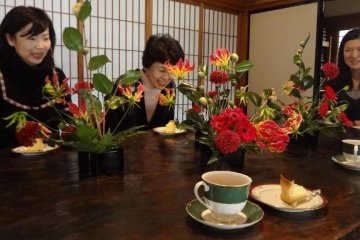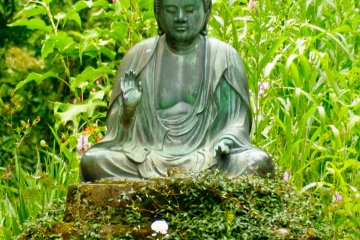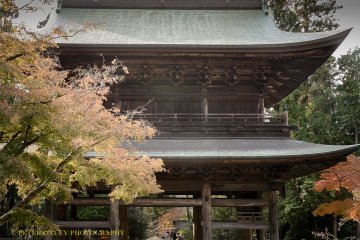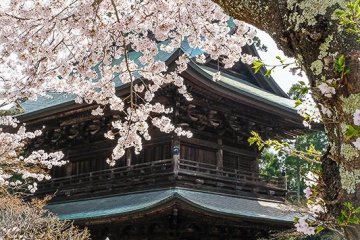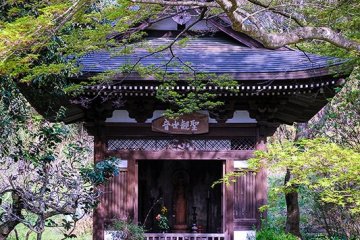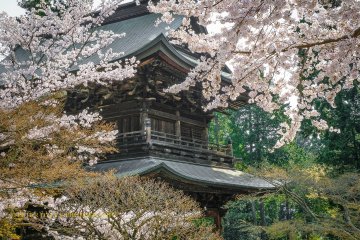What could be more inspiring and auspicious than a herd of white deer appearing apparently out of nowhere to attend the inaugural ceremony of a newly consecrated temple? Well, that’s exactly what happened, or so legend has it, when the chief priest and Zen master Mugaku Sogen gave his sermon at the opening ceremony of Engakuji Temple way back in 1282. There’s a marker at the cave, the Hakuroku-do, to show the location from where the deer appeared.
Built to Appease the Souls of Those Who Died in the Mongol Wars
Engakuji Temple was constructed on the grounds of a hermitage owned by Hojo Tokimune, the eighth regent of the Kamakura shogunate (1185-1333). It was built to appease the souls of both defenders and invaders who perished in the Mongol invasions of 1274 and 1281, both incursions stopped fortuitously by strong winds and rains that sunk most of the invading fleets, sparing the hugely outnumbered Japanese defenders. Deemed a godsent intervention, the typhoons came to be known as kamikaze, meaning divine wind.
The name Engakuji was chosen because during excavations preceding construction, a chest was unearthed containing The Sutra on Perfect Enlightenment. Engaku means perfect enlightenment in English, hence the name of the temple.
Kamakura's hierarchical Go-Zan System Evolved to Control the Populace
Engakuji was ranked second of the five Zen Buddhist temples of Kamakura that included Kenchoji, Jufukuji, Jochiji, and Jomyoji. Collectively, they are known as the Kamakura Go-zan, five mountain temples. Controlled and protected by the shogunate, in other words, the Hojo family, and later, after their demise, the Ashikaga, the Go-zan system allowed an hierarchical network of Zen temples to function as de facto ministries that effectively controlled the populace under the guise of a religious institution.
At one time there were more than 40 buildings on the grounds of Engakuji, but today there are only some 20 remaining structures, many having been destroyed by earthquakes and other natural disasters.
A Variety of Structures, Each With Its Own Story
Most of the interest for the visitor today centers on the main gate Sanmon, the main hall Butsuden, and the reliquary hall Shariden (generally not open to the public), which contains an important relic, a tooth of the Buddha. In the Butsuden, there is an interesting painting on the ceiling of a dragon coming out of the clouds, which is symbolic of rain falling from the skies and spreading enlightenment on the worshippers below.
Engakuji is situated in a V-shaped valley, which means that wherever you look, you are always surrounded by greenery. Two rows of ancient junipers line the approach to the Butsuden. At the end of the valley there is a small shrine, Obaiin, and behind it, burial caves (yagura) carved into the hillside. Obaiin is dedicated to the Buddhist monk, calligrapher, and master garden designer Muso Soseki.
On the way to this shrine, there are a couple of teahouses where you can relax and enjoy matcha green tea.
There is also a pond laid out amid the essential elements of a traditional Zen garden. Here, you may find turtles sunning themselves on the surrounding rocks on a fine day.
A Panoramic View of the Temple and the Surrounding Hills
To the far left up the hill, some buildings occasionally hold art exhibitions. From this vantage point, you can take in a panoramic view of the temple grounds. On the far right, steep stone steps lead up to a bell tower that houses the largest temple bell, Ogane, in the whole of the Kanto area, cast in 1301. Standing in front of the tower is an old wooden shrine, Bentendo, dedicated to Benzaiten, goddess of water and music. Benzaiten is one of the Seven Lucky Gods of Japan and, incidentally, the only female one. Here, you can also enjoy a bird's-eye view of the hills surrounding Kamakura City and, if you wish, an alfresco drink and bite to eat from a kiosk nearby.
A Great Supporter of Zen Buddhism and the Samurai Warrior Class
A great supporter of Zen Buddhism and the samurai warrior class, Hojo Tokimune became regent of the shogunate at the young age of 17 but kept a firm grip on the reins of power until his death 15 years later. Mugaku Sogen was the spiritual advisor and mentor who gave him the courage to face the threats posed by the formidable Mongol and Chinese forces under the powerful Kublai Khan.
Revered as a hero in Japan, Tokimune has appeared as a character in countless movies, plays, and anime, as well as in an NHK television miniseries. For almost 700 years until 1945, he was the last ruler to successfully defend the country from outside invaders.
Flowering Trees and Plants and Fresh Mountain Air
Located very close to JR Kita-Kamakura station, Engakuji is much loved and admired by the Japanese people and is very popular with local residents. Often you will see a group of school children enjoying the quiet, open spaces, a dog walker, or a solitary figure reading a book. Peace and tranquility are palpable here. And for the visitor who wants to take a more immersive part in a unique aspect of Japanese history and culture, zazen sessions are available by reservation at the Hojo.
There is much more to see and enjoy besides history, in particular the many flowering trees and plants: plum, cherry blossom, hydrangea, camellia, and, of course, the autumn colors. It’s a good place to stroll and breathe in the fresh air.
I thoroughly recommend a visit to Engakuji. Basking in a marvelous atmosphere of silence punctuated by birdsong, it takes you away from the sometimes vexing hurly-burly of Kamakura’s much more crowded tourist spots. And, with a little stretch of the imagination, you might almost expect to see a herd of white deer rounding the corner….





